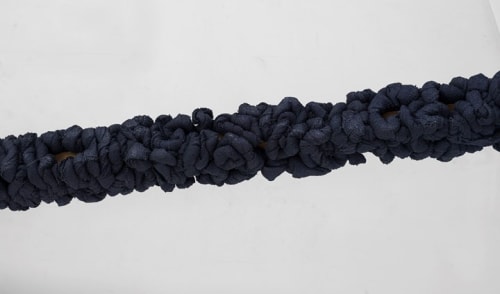Among the works on view were shawls embroidered by master weaver Zamthingla Ruivah, who embeds images of dissent in her fabrics to commemorate the violence inflicted on her native Nagaland in North Eastern India by the Indian army. The Luingamla Kashan (1990-present), for instance, are a series of shawls made in memory of Luingamla, an 18-year-old girl who was killed by the Indian army for resisting sexual assault. Sewn onto red cloth are repetitive, geometric motifs that represent animist symbols, which were lost when the community was converted to Christianity. Immune to the interpretations of the Indian government, the garment is an ultimate act of subversion that abstractly testifies to the support and unity that followed Luingmala’s death. Today, these shawls represent a symbol of community, and are worn by women in the area as a sign of solidarity.
Also standing in peaceful protest, albeit as a reminder of a different historical struggle, was Manish Nai’s Untitled (2017): five large sticks wrapped in compressed strips of burlap dyed indigo leaning upright against a wall. The work recalls the bloody history of indigo planting in Bengal, when the British turned farmers from food to indigo cultivation, offering loans at interest rates that left farmers, forced to convert their crop, in debt. (The frustration and despair caused by the resultant precarity swelled into an uprising in 1859 that was violently suppressed by colonial forces.)

